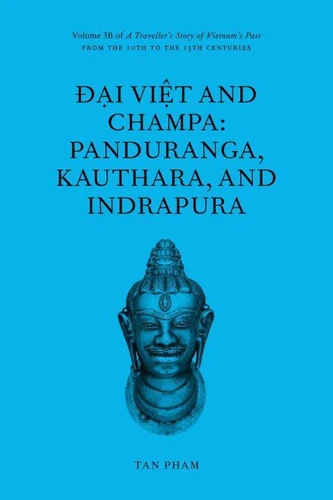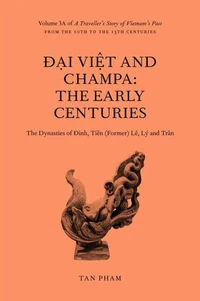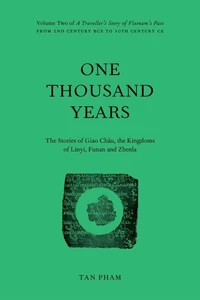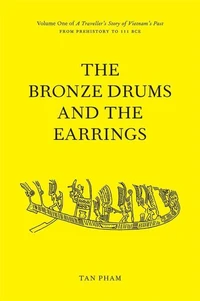Đại Việt and Champa: Panduranga, Kauthara, and Indrapura. A Traveller's Story of Vietnam's Past, #3
Par :Formats :
Disponible dans votre compte client Decitre ou Furet du Nord dès validation de votre commande. Le format ePub est :
- Compatible avec une lecture sur My Vivlio (smartphone, tablette, ordinateur)
- Compatible avec une lecture sur liseuses Vivlio
- Pour les liseuses autres que Vivlio, vous devez utiliser le logiciel Adobe Digital Edition. Non compatible avec la lecture sur les liseuses Kindle, Remarkable et Sony
 , qui est-ce ?
, qui est-ce ?Notre partenaire de plateforme de lecture numérique où vous retrouverez l'ensemble de vos ebooks gratuitement
Pour en savoir plus sur nos ebooks, consultez notre aide en ligne ici
- FormatePub
- ISBN8230965718
- EAN9798230965718
- Date de parution07/11/2024
- Protection num.pas de protection
- Infos supplémentairesepub
- ÉditeurIndependently Published
Résumé
Most travellers to Vietnam will, at some point, visit a Cham tower or view some Cham artefacts in a museum. These were left behind by the Cham people of the now-vanished kingdom of Champa. They are unique, exquisite, and mythical. The people who built and carved these beautiful works once inhabited central Vietnam and the northern part of the south, which stretches over 1, 000 kilometres from north to south.
Today, with a population of less than 200, 000, the Chams live primarily in Ninh Thu?n, Bình Thu?n, and other provinces in the Mekong Delta. Champa's history is broadly divided into three eras: the First Era (5th to 10th centuries), the Second (10th to 15th centuries), and the Third (15th to 19th centuries). This book deals with the First Era, including the three great Houses of Ga?garaja, Vicitrasagara, and Ujora at three locations.
The first house is associated with Simhapura, modern Trà Ki?u in Qu?ng Nam province. The second house is connected with Virapura and Po Nagar in Panduranga and Kauthara, present-day Ninh Thu?n, Bình Thu?n, and Khánh Hòa provinces. The third house is linked with Indrapura, D?ng Duong Monastery in Qu?ng Nam province. The book also presents an overview of Champa, a description of the Cham tower and maps of Cham ruins in Qu?ng Bình, Qu?ng Tr?, and Th?a Thiên-Hu? provinces.
To collect materials for this volume, the author visited most of the sites mentioned in the book and referred to Cham inscriptions, Chinese and Vietnamese historical works. Dr. Anne-Valérie Schweyer, the Research Director at CNRS (French National Centre for Scientific Research), an epigraphist and a world-leading scholar in Champa studies, commented and wrote the foreword for the book. She concludes: "Through his travels, Tan Pham unravels the history and art of the Cham kingdoms from the time of their creation to their apogee, while at the same time making their present-day presence visible.
It is a great pleasure to follow in his footsteps, which lead to a better understanding of a glorious part of Vi?t Nam's history." This book is one of four volumes covering the period of Vietnamese history from the 10th to the 16th centuries. The other volumes are 3A, 3C and 3D of the book series A Traveller's Story of Vietnam's Past. They continue where Volume II, One Thousand Years - The Stories of Giao Châu, the Kingdoms of Linyi, Funan and Zhenla, and Volume I, The Bronze Drums and The Earrings end.
The book has 360 pages and contains 99 figures and illustrations.
Today, with a population of less than 200, 000, the Chams live primarily in Ninh Thu?n, Bình Thu?n, and other provinces in the Mekong Delta. Champa's history is broadly divided into three eras: the First Era (5th to 10th centuries), the Second (10th to 15th centuries), and the Third (15th to 19th centuries). This book deals with the First Era, including the three great Houses of Ga?garaja, Vicitrasagara, and Ujora at three locations.
The first house is associated with Simhapura, modern Trà Ki?u in Qu?ng Nam province. The second house is connected with Virapura and Po Nagar in Panduranga and Kauthara, present-day Ninh Thu?n, Bình Thu?n, and Khánh Hòa provinces. The third house is linked with Indrapura, D?ng Duong Monastery in Qu?ng Nam province. The book also presents an overview of Champa, a description of the Cham tower and maps of Cham ruins in Qu?ng Bình, Qu?ng Tr?, and Th?a Thiên-Hu? provinces.
To collect materials for this volume, the author visited most of the sites mentioned in the book and referred to Cham inscriptions, Chinese and Vietnamese historical works. Dr. Anne-Valérie Schweyer, the Research Director at CNRS (French National Centre for Scientific Research), an epigraphist and a world-leading scholar in Champa studies, commented and wrote the foreword for the book. She concludes: "Through his travels, Tan Pham unravels the history and art of the Cham kingdoms from the time of their creation to their apogee, while at the same time making their present-day presence visible.
It is a great pleasure to follow in his footsteps, which lead to a better understanding of a glorious part of Vi?t Nam's history." This book is one of four volumes covering the period of Vietnamese history from the 10th to the 16th centuries. The other volumes are 3A, 3C and 3D of the book series A Traveller's Story of Vietnam's Past. They continue where Volume II, One Thousand Years - The Stories of Giao Châu, the Kingdoms of Linyi, Funan and Zhenla, and Volume I, The Bronze Drums and The Earrings end.
The book has 360 pages and contains 99 figures and illustrations.
Most travellers to Vietnam will, at some point, visit a Cham tower or view some Cham artefacts in a museum. These were left behind by the Cham people of the now-vanished kingdom of Champa. They are unique, exquisite, and mythical. The people who built and carved these beautiful works once inhabited central Vietnam and the northern part of the south, which stretches over 1, 000 kilometres from north to south.
Today, with a population of less than 200, 000, the Chams live primarily in Ninh Thu?n, Bình Thu?n, and other provinces in the Mekong Delta. Champa's history is broadly divided into three eras: the First Era (5th to 10th centuries), the Second (10th to 15th centuries), and the Third (15th to 19th centuries). This book deals with the First Era, including the three great Houses of Ga?garaja, Vicitrasagara, and Ujora at three locations.
The first house is associated with Simhapura, modern Trà Ki?u in Qu?ng Nam province. The second house is connected with Virapura and Po Nagar in Panduranga and Kauthara, present-day Ninh Thu?n, Bình Thu?n, and Khánh Hòa provinces. The third house is linked with Indrapura, D?ng Duong Monastery in Qu?ng Nam province. The book also presents an overview of Champa, a description of the Cham tower and maps of Cham ruins in Qu?ng Bình, Qu?ng Tr?, and Th?a Thiên-Hu? provinces.
To collect materials for this volume, the author visited most of the sites mentioned in the book and referred to Cham inscriptions, Chinese and Vietnamese historical works. Dr. Anne-Valérie Schweyer, the Research Director at CNRS (French National Centre for Scientific Research), an epigraphist and a world-leading scholar in Champa studies, commented and wrote the foreword for the book. She concludes: "Through his travels, Tan Pham unravels the history and art of the Cham kingdoms from the time of their creation to their apogee, while at the same time making their present-day presence visible.
It is a great pleasure to follow in his footsteps, which lead to a better understanding of a glorious part of Vi?t Nam's history." This book is one of four volumes covering the period of Vietnamese history from the 10th to the 16th centuries. The other volumes are 3A, 3C and 3D of the book series A Traveller's Story of Vietnam's Past. They continue where Volume II, One Thousand Years - The Stories of Giao Châu, the Kingdoms of Linyi, Funan and Zhenla, and Volume I, The Bronze Drums and The Earrings end.
The book has 360 pages and contains 99 figures and illustrations.
Today, with a population of less than 200, 000, the Chams live primarily in Ninh Thu?n, Bình Thu?n, and other provinces in the Mekong Delta. Champa's history is broadly divided into three eras: the First Era (5th to 10th centuries), the Second (10th to 15th centuries), and the Third (15th to 19th centuries). This book deals with the First Era, including the three great Houses of Ga?garaja, Vicitrasagara, and Ujora at three locations.
The first house is associated with Simhapura, modern Trà Ki?u in Qu?ng Nam province. The second house is connected with Virapura and Po Nagar in Panduranga and Kauthara, present-day Ninh Thu?n, Bình Thu?n, and Khánh Hòa provinces. The third house is linked with Indrapura, D?ng Duong Monastery in Qu?ng Nam province. The book also presents an overview of Champa, a description of the Cham tower and maps of Cham ruins in Qu?ng Bình, Qu?ng Tr?, and Th?a Thiên-Hu? provinces.
To collect materials for this volume, the author visited most of the sites mentioned in the book and referred to Cham inscriptions, Chinese and Vietnamese historical works. Dr. Anne-Valérie Schweyer, the Research Director at CNRS (French National Centre for Scientific Research), an epigraphist and a world-leading scholar in Champa studies, commented and wrote the foreword for the book. She concludes: "Through his travels, Tan Pham unravels the history and art of the Cham kingdoms from the time of their creation to their apogee, while at the same time making their present-day presence visible.
It is a great pleasure to follow in his footsteps, which lead to a better understanding of a glorious part of Vi?t Nam's history." This book is one of four volumes covering the period of Vietnamese history from the 10th to the 16th centuries. The other volumes are 3A, 3C and 3D of the book series A Traveller's Story of Vietnam's Past. They continue where Volume II, One Thousand Years - The Stories of Giao Châu, the Kingdoms of Linyi, Funan and Zhenla, and Volume I, The Bronze Drums and The Earrings end.
The book has 360 pages and contains 99 figures and illustrations.






